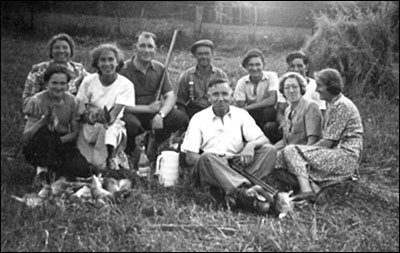|
The recent death of Miss Daisy Denton, at the age of 88, recalled the many years her family farmed in the town.
In 1930 Mr Albert Sharman Denton moved from Brigstock and purchased the Home Farm on the High Street. (Click here for Town Trail point 19) (Not to be confused with Home Farm on
Kettering Road
which has been farmed by the Bennie family for nearly 70 years.) The farmhouse was a rambling 18th century stone building with a Collyweston slate roof and wind cheater chimney stacks, and a fine range of stone barns. A small front garden was enclosed with a wooden fence.
To the left of the house bordering the street, two stone steps led to a raised garden which stretched down to the entrance to the Poplars, now the council offices. From the back window of the Council Chamber one could look down onto the cattle in the crew yard.
Mr and Mrs Denton had three children, Edgar, Minnie and Daisy. Edgar married Sarah Corney and lived in Ivy Cottage, near
Cranford. The Corneys still farm in the area at the Round House. Minnie married Vincent Holland, who farmed at Hilly Farm just across the High Street. His parents lived at Fernbank in
Church Lane
. The
Hollands
later moved and farmed at Moulton. Daisy never married.
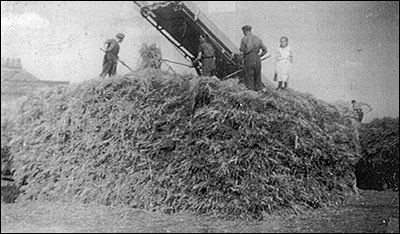 |
|
Threshing time in the early 1950s.
Pictured are Ray Annis,
Jack Craddock, Edgar Denton
and his daughter Mary Denton.
|
|
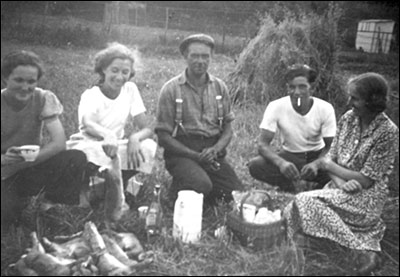 |
Taking a break, 1950.
Seated here are Mary Denton,
Margaret Thurlow, Edgar Denton,
Jack Craddock and Sarah Denton.
(This photo and the one at the top of the back both kindly loaned by Margaret Craddock (nee Thurlow)
|
|
Daisy rose about 5 am every morning, seven days a week, and would light a fire in the big kitchen range. After the early jobs were done breakfast would be eaten at the long, scrubbed table: bacon, eggs and sausages fried, on the range, in dripping! (None of your low fat oils in those days!)
A fire was lit in the adjoining dining room in time for “Dinner” at midday. Then, in the late afternoon, tea was enjoyed in front of a blazing fire in the sitting room which was to the left of the front door. Tea would include cream cakes from Barlow’s cake shop, a few doors away, which is now the Indian Takeaway. In earlier times, the second front room of the farmhouse was used, two days a week, by the local bank!
As a boy, I remember going to the back door to buy eggs. Mrs Denton, who hobbled on crippled feet, also sold milk, cream and butter made in the dairy. On Sunday mornings, brussel sprouts, still on their stalks, could be bought for a shilling.
Daisy milked the cows, nurtured the young calves and would deliver milk around the town on her bicycle. She also drove the cattle down the High Street, wielding a stick! At harvest-time, she would take refreshments into the fields for the harvesters. Daisy was kind to the POWs who worked on the farm.
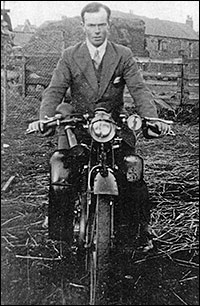 |
|
Edgar Denton c1930
|
|
June Smith has happy memories of when she and her late husband, Jack, kept Smith’s Newsagents (now Burton Newsagents) on the High Street. Edgar Denton, although living at Cranford, came over seven days a week and spent all day on the
Burton
Farm and enjoyed good meals in the house. On his way home in the evening he would call at the shop for his St Bruno Flake tobacco. In fact he actually named the farm dog, a boxer, Bruno! So attached was Bruno to Edgar that the dog could be seen standing at the farm gate, or sometimes pushing the shop door open, looking for him. Bruno was quite harmless although some people would cross the road, rather than pass him!! Edgar had another dog, a sheep collie named Bobby, who would sit by his side in the Land Rover.
One evening he drove Jack and June over to
Cranford
to show them his land that had been reclaimed after ironstone mining. Edgar’s daughter, Mary, also worked on Burton Farm. She was a pretty girl and had the Corney auburn hair.
After the death of her parents, Daisy lived alone in the big farmhouse. In his will Mr Denton left £2,357 15s 4d. The farmland included the fields bordering the allotments, (now occupied by the schools and houses in Park Road) and the field at the top of Pioneer Avenue which, in 1937, was sold and became St George V playing field now more familiarly known as the Recreation Ground. This enabled a road to be constructed linking
William Street
with
Pioneer Avenue
. Prior to that,
William Street
ended in a metal fence and
Pioneer Avenue
, a hedge.
Other land farmed by the Dentons was off
Finedon Road
. They also owned half of Hogs Hole spinney, which was divided by a stream, the other half of which was owned by my grandfather, John Meadows.
The field behind the farmyard became a fairground each year when Burton Feast was celebrated with a visit from Thurston’s Amusements. In those days the nearest Sunday to August 26 attracted large crowds. After attending church, people would wander around the beautiful grounds of the Rectory, listen to the Britannia Band and walk along the High Street chatting to relatives and friends. How I remember ancient aunts, wearing big hats, descending on us at Regent House for tea and a good gossip. My sister, Kathleen, and I eyed them suspiciously and kept out of the way!
During the last war the cellar of the
Denton
’s farmhouse was used as an air raid shelter and it was after the war
Burton
began to change. By the early 1960s many of the old houses and cottages in the yards off the main streets were declared unfit for habitation; the owners being unable, or reluctant, to modernise, had their properties demolished. Today these houses would have been tastefully converted and preserved.
The main clearance was off the High Street. School Lane and Croxens Yard (now Latimer Close and Burton House) were completely demolished and the High Causeway cottages on the other side of the High Street were replaced by the Health Centre and Library in the early 1970s.
In 1965, the
Denton
family decided to sell up. Their fine old farmhouse and land extending to about 47 acres was sold for £86,000 for development. It was said that the farmhouse would have to be sacrificed to make the access road and although it was a listed building, and in spite of much public concern, the house was eventually demolished in a cloud of dust that filled the High Street. Thus,
Churchill Way
was constructed.
To read more about the demolition of the Denton Farmhouse and the construction of Churchill Way, click here.
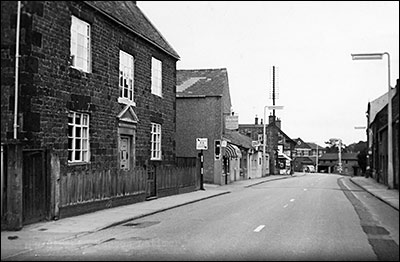 |
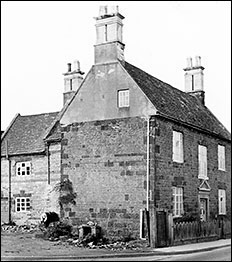 |
|
Denton Farmhouse, High Street, in 1955
|
Denton Farmhouse just prior to its
demolition in the mid 1960's
|
At my suggestion, the fine 18th century stone pedimented front doorway was saved and re-erected at
44 High Street
(the old house behind Burton Newsagents) by Ben and Joan Holmes whose home it was then. It is still there today. Some say that the old farmhouse itself could have been saved by re-designing the access road. Unfortunately, it was a suggestion that came too late as fields, where cattle and sheep once grazed, were replaced by bricks and concrete.
Click here to view a movie clip of Denton's Farm in the early 1960s.
To view it correctly, you may need to download the Quicktime Player if you don't have it installed. Users with a dial-up connection are asked to be patient during the loading time.
The clip shows a tractor coming down the the High Street and turning into Denton's Farm - a reminder of the fact that there were once more than five working farms in Burton High Street. There is a view of the yard from the High Street, and a brief shot of a Land Rover entering the yard, with Bobby the dog in the back. The clip ends with a view of the farmhouse and the High Street
Movie clip kindly loaned by Carol Desborough
|
The
Denton
s continued to farm, purchasing Hillsborough Farm and building a new farmhouse on the
Finedon Station Road
above the railway.
Towards the end of his life Edgar was almost blind. Daisy fetched him from
Cranford
each day when he would sit outside on a bench and enjoy chatting to passing friends. He died in 1988 aged 85. Edgar was a good sincere and honest countryman. His greatest love had been his sheep and at his funeral service in
St John’s
Church
,
Cranford
, the Rector took as his address “The Good Shepherd.”
At the age of 83, Daisy, who had never taken a holiday and was by now troubled with arthritis, sold the Hillsborough Farm and moved to Great Addington to live in a cottage near her niece, Mary. There she spent her last five years and now leaves with us the memory of a true countrywoman who cared deeply for the land and its animals.
The family name is commemorated in Burton Latimer with
Denton Court
.
|
